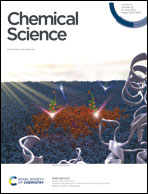N-Hydroxybenzimidazole as a structurally modifiable platform for N-oxyl radicals for direct C–H functionalization reactions†
Abstract
Methods for direct functionalization of C–H bonds mediated by N-oxyl radicals constitute a powerful tool in modern organic synthesis. While several N-oxyl radicals have been developed to date, the lack of structural diversity for these species has hampered further progress in this field. Here we designed a novel class of N-oxyl radicals based on N-hydroxybenzimidazole, and applied them to the direct C–H functionalization reactions. The flexibly modifiable features of these structures enabled facile tuning of their catalytic performance. Moreover, with these organoradicals, we have developed a metal-free approach for the synthesis of acyl fluorides via direct C–H fluorination of aldehydes under mild conditions.



 Please wait while we load your content...
Please wait while we load your content...